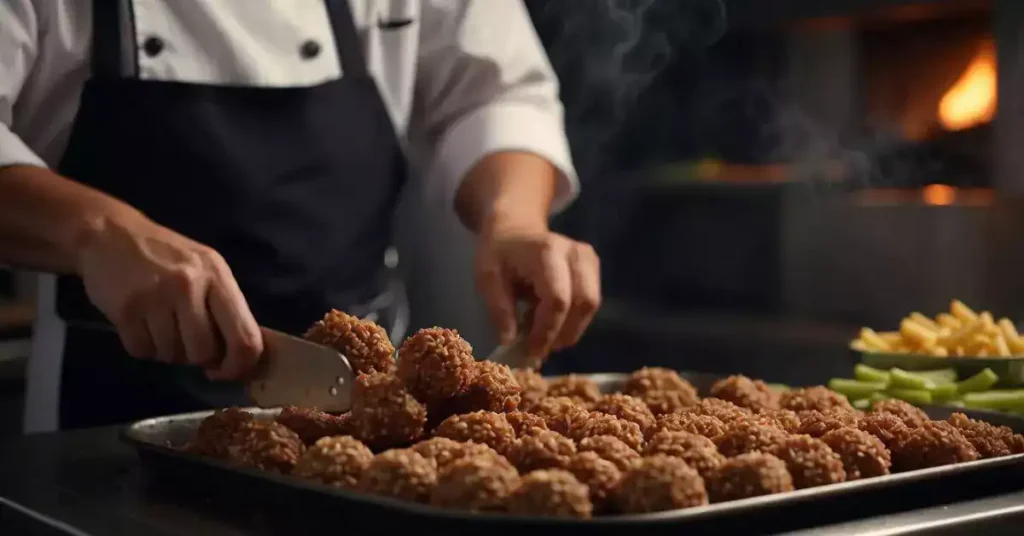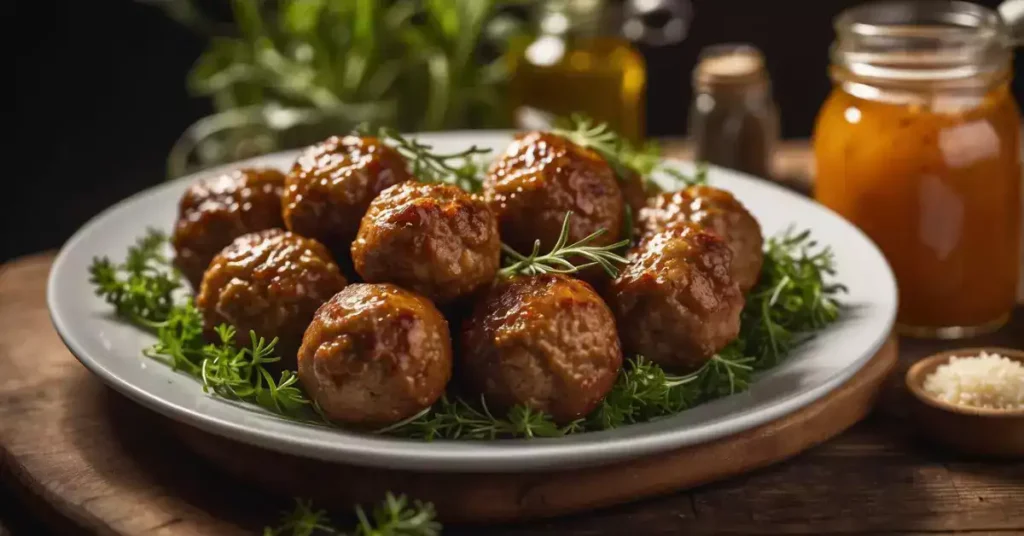Bring the flavors of Germany directly to your dining room with our recipe for German Meatballs. Discover how to recreate the authentic taste in your own kitchen using a handful of essential techniques and ingredients that truly set it apart. We’re divulging our top advice exclusively for you. Let’s get started!
Overview of German Meatballs
In this section, you’ll discover the rich flavors and history of German meatballs, not just any meatball, but the ones that hold a special place in Germany’s culinary tradition.
What Are German Meatballs?
German meatballs, which you might have heard called Königsberger Klopse or Frikadellen, vary in preparation across the region.
Königsberger Klopse are typically simmered in a broth and served with a creamy caper sauce. They hail from the former East Prussia, now the Kaliningrad area.
Frikadellen, on the other hand, are flatten meatballs that are fried and often served with potatoes or cabbage. These savory treats are more common throughout Germany and are a staple in German cuisine.
History and Cultural Significance
The history of German meatballs like Königsberger Klopse dates back to the 18th century in East Prussia. This German dish has evolved over the years and made its way into the hearts (and menus) around the country, exhibiting regional differences.
In some regions, they’re a beloved comfort food, often enjoyed with family and friends. The evolution of these meatball recipes reflects the blending of local tastes and available ingredients, showcasing the diversity of German culinary practices.
Here’s a glimpse of how these meatballs vary across Germany:
| Region | Meatball Name | Characteristics | Typical Serving |
|---|---|---|---|
| Former East Prussia | Königsberger Klopse | Boiled in broth, served with caper sauce | Accompanied with boiled potatoes or rice |
| Nationwide | Frikadellen | Flattened, pan-fried | Often paired with potatoes, cabbage, or bread |
Preparing German Meatballs

One of the joys of German cuisine is its hearty, comforting dishes, and German meatballs, or “Frikadellen,” are a perfect example.
To craft these savory delights at home, follow this guide that breaks down the ingredients, gives step-by-step instructions, and offers recipe tips and variations to suit your taste.
Ingredients Breakdown
Meats: You’ll need both ground beef and ground pork for a juicy blend of flavors.
Binder: Combine the meats with eggs and breadcrumbs; soaking the breadcrumbs in milk helps the meatballs stay together.
Seasonings: Balance the flavors with salt, black pepper, finely chopped onion, and a hint of nutmeg and paprika for that authentic German taste.
Frying: To cook, olive oil or unsalted butter are recommended for frying the meatballs to a golden-brown perfection.
Sauce: For a typical “Königsberger Klopse” style, include capers and lemon juice in the sauce for a tangy finish.
Step by Step Instructions
- Combine Ingredients: In a bowl, mix the ground meats, soaked breadcrumbs (bread mixed with milk), one egg, finely diced onion, salt, pepper, and spices until well blended.
- Form Meatballs: Shape the mixture into evenly sized balls.
- Cook: Fry the meatballs in oil or butter for a crispy outside, or simmer in beef or vegetable broth for tender meatballs.
Recipe Tips and Variations
- Mix it Up: Feel free to adjust the meat ratio or use just beef or pork for different flavors.
- Customize the Sauce: Create variations of the sauce with the addition of anchovies, mustard, or whipping cream to create a diverse range of flavors that cater to your palate.
- Healthier Option: Use olive oil instead of butter for a lighter version, or bake the meatballs instead of frying to reduce fat content.
Nutrition and Storage

When enjoying German meatballs, it’s important to consider the nutritional content and how best to store them for future enjoyment. Here’s what you need to know.
Health Considerations
German meatballs, or Frikadellen, and their variations like Königsberger Klopse mit Soße, can vary in their nutritional content. Typically, they contain:
- Calories: A standard serving has significant calories due to the meat and binding ingredients.
- Fat: As they are often made with beef or pork, fat content can be high, but leaner meats may reduce this.
- Cholesterol & Sodium: These are naturally present in the meat and added seasoning.
- Carbohydrates: Usually low unless served with gravy or sauces high in sugar.
- Protein: An excellent source of protein, which is vital for your muscle repair and growth.
| Nutrition Fact | Average Amount per Serving |
|---|---|
| Calories | 250-350 |
| Fat | 10-20g |
| Cholesterol | 50-80mg |
| Sodium | 500-800mg |
| Carbohydrates | 5-15g |
| Protein | 20-30g |
Please note that the above is an estimation and actual values may vary based on the recipe and portion size. Always check nutrition facts if available.
Proper Storage Tips
To ensure your meatballs remain delicious after preparation, follow these storage tips:
- Refrigeration: Store in an airtight container and keep them in the fridge for up to 3-4 days.
- In Gravy: If they are in gravy, ensure they are cooled before placing them in the fridge to maintain the flavor and texture.
- Separation: Store the gravy separately from the meatballs to avoid them becoming too soggy.
- Freezing: Place the cooled meatballs on a baking sheet, freeze them until solid to prevent sticking, then transfer to a freezer bag or container. They will keep for about 2-3 months.
- Reheating: Thaw overnight in the refrigerator if possible, and reheat in a saucepan or in the oven until thoroughly warm. If they’re with gravy, combine and reheat gently to avoid the sauce separating.
Our Opinion about German Meatballs
German Meatballs are a great recipe. The great thing about them is that they can be used as a main course, side dish or snack.
As a main course with a few vegetables and potatoes, they are unbeatable fresh from the pan.
You can’t go wrong with them as finger food at a party in the evening either. Just try them out at home.
FAQ about German Meatballs
How do you make German meatballs?
German meatballs are typically made with a mixture of ground beef and pork, along with breadcrumbs, onions, and a blend of spices like salt, pepper, and nutmeg.
What is the traditional side dish for German meatballs?
German meatballs are often served with a side of creamy mashed potatoes or buttered noodles.
Can German meatballs be frozen?
Yes, German meatballs can be frozen after they are cooked. Simply allow them to cool, then store them in an airtight container or freezer bag for up to 3 months.
Do you like this recipe for German Meatballs? Let us know in the comments below.






